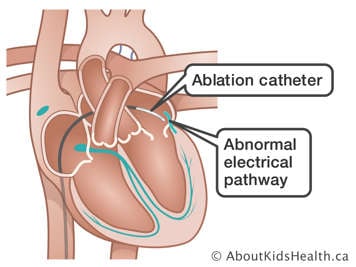What is catheter ablation?
Catheter ablation is done in the Cardiac Diagnostic and Interventional Unit (also known as the CDIU or cardiac [heart] catheterization laboratory) to correct abnormal fast heart rates.

What are tachyarrhythmias?
Tachyarrhythmias are fast (racing) heartbeats that are abnormal. These fast heart rates are caused by abnormal electrical circuits in the heart. Sometimes these arrhythmias are treated with medication, and sometimes they need to be treated with catheter ablation.
What is heart catheterization?
During the heart catheterization procedure, the doctor carefully puts a long, thin tube or wire called a catheter into a vein or artery in your child's neck or groin. The groin is the area at the top of the leg. Then, the catheter is threaded through the vein or artery into your child's heart.
The doctor who does the procedure is a cardiac electrophysiologist, which means a doctor who specializes in the electrical systems of the heart. This may not be your child's regular cardiologist.
To learn about heart catheterization, please see Heart catheterization: Getting ready for the procedure.
There are small risks associated with the procedure
Generally, heart catheterization is a fairly low-risk procedure, but it is not risk-free. The doctor will explain the risks of heart catheterization to you in more detail before you give your consent for the procedure. The most common risks with catheter ablation are as follows:
The catheter may break through a blood vessel
There is a very small risk that the catheter may break through a blood vessel or the heart wall. To reduce this risk, we use soft catheters and sometimes a type of X-ray called fluoroscopy to see where the catheter is.
There is a small risk of new heart rhythm problems
Sometimes the procedure can interfere with the heart's electrical system and cause new problems with the heartbeat. If this occurs, your child's cardiologist will discuss it with you in more detail.
For general information about the risks of heart catheterization, please see Heart catheterization: Getting ready for the procedure.
What happens during the procedure
The procedure is performed while your child is under a general anesthetic. This means that your child will be asleep during the procedure.
Finding the abnormal circuit
The doctor threads a special catheter through your child's blood vessels to the heart. The catheters have magnet markers on them so they can be seen on an imaging system. A special type of X-ray called fluoroscopy may also be used so the doctor can see where the catheter is located.
Electrical signals sent by the heart travel through the catheters. These signals give information about the heart's electrical system. The doctor also uses the catheters to trigger the fast heart rate. This helps the doctor find the abnormal area in the heart.
Destroying the abnormal circuit
After the cardiologist finds the circuit that causes your child's heart to beat fast, they heat or cool the heart tissue to get rid of the abnormal electrical pathway that allows the fast heartbeats to occur.
The procedure will take three to six hours
The procedure time varies but typically lasts three to six hours. After the procedure, your child will go to the recovery room to wake up from the anesthetic. Once awake and recovered from anesthetic your child will usually be discharged home. In some cases, your child will remain in hospital overnight for observation.
After the procedure
After the procedure, your child will likely have a pressure bandage on the catheterization sites for about 4 hours to help prevent any bleeding. Before your child goes home these will be removed and an adhesive bandage applied. Your child should not have a bath or swim until their catheterization sites are healed, but they may shower.
Your child should minimize sports activities for about one week after the procedure. After that they may resume all regular activities.
You should arrange a follow-up visit with your child’s primary care provider 1 to 2 weeks after the procedure. They will examine the catheterization sites for tenderness or swelling and ask about any pain.
Your child will receive a follow-up appointment with their primary cardiologist in the community in 2 to 3 months. If they are not followed by cardiology elsewhere, we will arrange a follow-up visit at SickKids.
For information on what to do after your child goes home, please see Heart catheterization: Caring for your child after the procedure.
After the ablation, children often feel that their heart is about to race. This feeling is normal. It is caused by single early beats that may have started the heart racing before the procedure. However, these events should no longer cause the heart to race. If your child does have a racing heartbeat after the procedure, call your child’s cardiologist so they may advise if any tests are recommended.
Acetylsalicylic acid (ASA or Aspirin) to prevent blood clots
Some patients may need to take ASA for two to three months after the procedure. This will help to prevent blood clots from forming in the area where the pathway was interrupted. The health-care team will tell you how much ASA to give your child before your child goes home.
Stop giving the ASA and call your child's primary health-care provider if:
- your child has a cold or fever
- your child is exposed to chickenpox
In general, you should give your child acetaminophen for fever and colds, as directed by your child's health-care provider. The health-care provider will tell you when you can start the ASA again.
If your child starts bruising easily, call your child's primary health-care provider.
Coming back for a check-up
Your child should have an ECG and see their primary cardiologist for a routine follow-up visit about 3 months after the procedure. A follow-up at SickKids will be arranged if your child does not have a local cardiologist.
